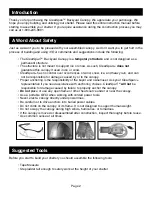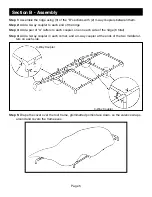
IMPORTANT - Read Anchoring Instructions
You must read the anchoring instructions packed with your kit prior to shelter assembly!
Selecting a Location
It is important to select a proper location for your poly shelter. While the location may have been
predetermined before you even ordered your shelter, you may want to “improve” the location before
starting the assembly process.
One of the most important considerations is that the location should be level. If it is not, the shelter
ʼ
s
frame will not assemble or sit properly. If your location is not level, you should consider grading it
before building on it. Another alternative is to provide footings which are level to support the shelter.
These could be pressure-treated posts, precast concrete blocks, or poured in place footings.
Drainage is another important consideration. Rain flowing off your shelter should have a natural path
to flow away from the shelter and not under or into it.
Section A - Unpack & Identify Parts
Step 1:
Before you begin to assemble your shelter you should first unpack the contents of your
shipment. During this process you will learn what all of the various parts look like.
Tip:
We recommend you start by laying out the contents of your shipment in an orderly fashion
as shown in the photograph below. Note that your parts may look different from those shown.
Step 2:
Carefully go through the bill of material that came with your shelter and verify that you have
all the required parts.
Tip:
It is not necessary to open the plastic bags and count all of the fasteners at this time.
Page 3

























